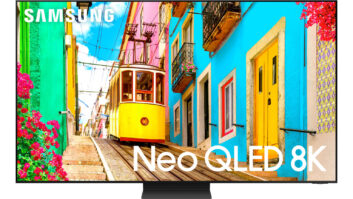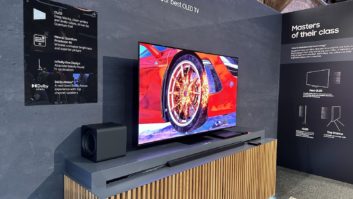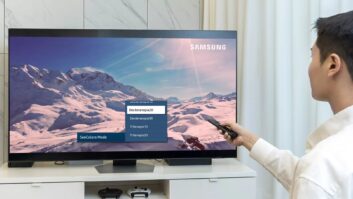New York — Samsung is stepping up its pursuit of A/V specialty and custom-install businesses, offering new programs, policies and products aimed at delivering high-performance, ultra-thin LCD and plasma sets that give dealers a hedge against shrinking margins in currently difficult market conditions.
That was the message on Tuesday from Tim Baxter, Samsung Electronics America consumer electronics division president, who
said Samsung sees Pioneer’s recent exit from TV as an opportunity to build its relationship with specialty A/V and custom-installation accounts that do the best job at selling step-up products with higher margins.
“Our over-arching strategy in TV has been to continue to move up stream, and we have done that quite effectively over the past few years,” Baxter told TWICE. “The [Touch of Color] line has helped us position ourselves well in the premium space. We see this as an opportunity to do the same in the plasma space, which has been a strategy for us this year.”
In addition to playing up its strengths with newly engineered ultra-thin plasma designs, Samsung’s biggest focus of the year is on LCD TVs with LED back-lighting technology. Baxter said that in addition to new ultra-thin, high-contrast plasma options for displaced Pioneer Kuro dealers and others, its top-of-the-line, ultra-slim, edge-lit LED TVs with 240Hz frame-rate technology should position Samsung at the top of the market in 2009.
Former Pioneer Kuro TV dealers have complained in recent weeks about an absence of 240Hz LED back-lit products from big-name LCD-only display vendors to help fill the gap.
Baxter, whose company now offers both high-performance plasma and 240Hz LED LCD TVs, said Samsung is using its strength in LED TV technology this year “as a new category” and not an extension of LCD or a replacement for plasma models.
“It’s about bringing in the best picture quality with its mega-contrast ratio,” Baxter said. “It is about leveraging the design technology around its edge-based lighting system that allows for a panel thinness of about an inch and it gives us the ability to offer a truly environmentally friendly solution that is lead-free, mercury-free and requires 40 percent less power to operate.”
Like Panasonic, which is also courting the A/V specialty dealers impacted by the Pioneer’s TV exit, Samsung has pledged to help high-end dealers impacted by shrinking prices and vendor resources, by implementing a new minimum advertised pricing (MAP) policy that for the first time lays out clear guidelines for Internet prices on both main pages and in online shopping carts.
“As the market leader, our retail partners are asking us for help in dealing with profitability erosion, and the consolidation of brands,” Baxter said. “We are also looking at how we properly position our brand to the consumer. We have taken a number of measures that include continually reinforcing the value of being an authorized Samsung dealer, by making sure that unauthorized retailers don’t use our intellectual property in manners inconsistent with our rights. We are also re-examining our MAP policy and at the request of many retailers … we are implementing a new policy that goes beyond the use of physical print advertising to cover online advertising.”
Baxter said the new policy has been communicated to dealers and goes into effect in the middle of April. He said the policy still fully provides the dealer the right to make his own decisions on selling prices, but it ties Samsung’s coop advertising support to the pricing terms it indicates for advertising, in addition to “other levers to help enforce the policy.”
Samsung, he said, it is also re-qualifying authorized online dealers, and will “materially reduce the number of pure play e-tailers that are, in fact, authorized.”
He said Samsung is now identifying e-tailers that best match Samsung’s brand strategy, and estimated that as many as a third of e-tailers Samsung has authorized to carry Samsung products could be cut back.
As for any new accounts Samsung hopes to gain from Pioneer’s TV exit, Baxter said Samsung “continues to evaluate our distribution partners … and we continue to tune our distribution based on the market needs, but I don’t see any wholesale changes.”
Samsung, he said, will continue to do business “with all the [retail] channels in the marketplace. It is our job to design the programs and portfolios that best meet each retailer’s strategy.”
Baxter said that while the economic downturn has been difficult for everyone, Samsung has been able to use the situation to take a closer look at things that weren’t addressed during the period of unheralded growth. Samsung, he said, will be “a little more disciplined on what we do from a marketing standpoint and on what we do for resource planning.”
Still, he said, “Samsung came out of 2008 with a CE business portfolio that grew by 35 percent, and a product line that grew more toward higher-end premium products than it did toward value solutions,” gaining 10 to 11 points of market share in TV (34 percent dollar market share) over the course of the year.
In the early months of 2009, he said, Samsung’s business is up by three times the industry average, and market share continues to grow “in the solid double digits.”
Regarding the aggressive advertising strategies that Samsung has employed to reach its market-leading status, Baxter said that while the economy requires a more prudent process, Samsung will “continue to invest in a significant way in the promotion the brand, but maybe on fewer platforms.”













